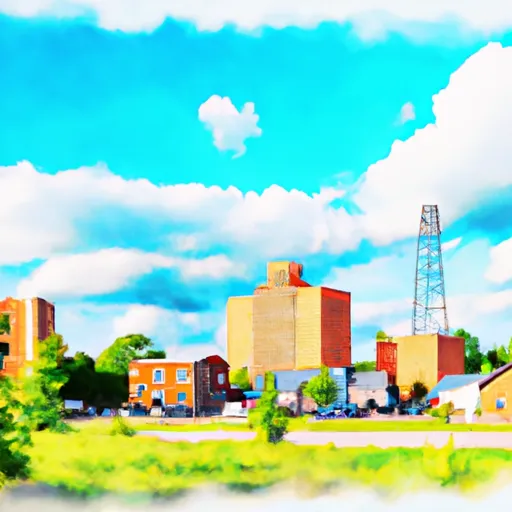-
 Snoflo Premium
Snoflo Premium
Get unlimited access to all our content
With no Ad interruptions! - Start Your Free Trial Login with existing account
Spalding
Eden Index
Climate
5.8
•
Recreation
0.6
•
Community
2.3
•
Safeguard
3.1/10

Spalding, located in Menominee County, Michigan, enjoys a temperate climate due to its proximity to Lake Michigan. Summers are mild, with average temperatures ranging from the mid-60s to low 80s Fahrenheit. Winters are cold, with temperatures typically ranging from the teens to the mid-30s. Snowfall is abundant, providing opportunities for winter activities like skiing, snowmobiling, and snowshoeing.
Hydrology plays a significant role in Spalding's outdoor attractions. The region is dotted with numerous lakes and rivers, including Lake Michigan and the Menominee River. These water bodies offer opportunities for boating, fishing, swimming, and kayaking. The Menominee River, in particular, is renowned for its challenging rapids, attracting whitewater enthusiasts from far and wide.
In terms of outdoor recreation, Spalding boasts an array of activities. The region is blessed with beautiful forests, making it ideal for hiking, camping, and wildlife observation. Hunters can explore the dense woodlands for deer, turkey, and small game. Birdwatchers can spot various species, including bald eagles and ospreys. Additionally, golfers can tee off at the scenic golf courses in and around Spalding.
Overall, Spalding offers a diverse range of outdoor activities, from water sports to winter adventures, making it an attractive destination for nature enthusiasts throughout the year.
What is the Eden Index?
The Snoflo Eden Index serves as a comprehensive rating system for regions, evaluating their desirability through a holistic assessment of climate health, outdoor recreation opportunities, and natural disaster risk, acknowledging the profound impact of these factors on livability and well-being.
Climate Health Indicator (CHI): 5.8
Spalding receives approximately
776mm of rain per year,
with humidity levels near 83%
and air temperatures averaging around
6°C.
Spalding has a plant hardyness factor of
4, meaning
plants and agriculture in this region thrive during a short period during spring and early summer. Most
plants will die off during the colder winter months.
By considering the ideal temperature range, reliable water supplies, clean air, and stable seasonal rain or snowpacks, the Climate Health Indicator (CHI) underscores the significance of a healthy climate as the foundation for quality living.
A healthy climate is paramount for ensuring a high quality of life and livability in a region, fostering both physical well-being and environmental harmony. This can be characterized by ideal temperatures, reliable access to water supplies, clean air, and consistent seasonal rain or snowpacks.
Weather Forecast
Streamflow Conditions
Northwestern Lake Michigan
Area Rivers
Northwestern Lake Michigan
Snowpack Depths
Northwestern Lake Michigan
Reservoir Storage Capacity
Northwestern Lake Michigan
Groundwater Levels
Recreational Opportunity Index (ROI): 0.6
The Recreational Opportunity Index (ROI) recognizes the value of outdoor recreational options, such as parks, hiking trails, camping sites, and fishing spots, while acknowledging that climate plays a pivotal role in ensuring the comfort and consistency of these experiences.
Access to outdoor recreational opportunities, encompassing activities such as parks, hiking, camping, and fishing, is crucial for overall well-being, and the climate plays a pivotal role in enabling and enhancing these experiences, ensuring that individuals can engage in nature-based activities comfortably and consistently.
Camping Areas
| Campground | Campsites | Reservations | Toilets | Showers | Elevation |
|---|---|---|---|---|---|
| Rossport - Rainbow Falls Provincial Park | 36 | 618 ft | |||
| Whitesand Lake - Rainbow Falls Provincial Park | 97 | 964 ft |
Nearby Ski Areas
Catastrophe Safeguard Index (CSI):
The Catastrophe Safeguard Index (CSI) recognizes that natural disaster risk, encompassing floods, fires, hurricanes, and tornadoes, can drastically affect safety and the overall appeal of an area.
The level of natural disaster risk in a region significantly affects safety and the overall livability, with climate change amplifying these risks by potentially increasing the frequency and intensity of events like floods, fires, hurricanes, and tornadoes, thereby posing substantial challenges to community resilience and well-being.
Community Resilience Indicator (CRI): 2.3
The Community Resilience Indicator (CRI) recognizes that education, healthcare, and socioeconomics are crucial to the well-being of a region. The CRI acknowledges the profound impact of these elements on residents' overall quality of life. By evaluating educational resources, healthcare accessibility, and economic inclusivity, the index captures the essential aspects that contribute to a thriving community, fostering resident satisfaction, equity, and social cohesion.

